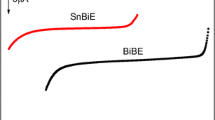Abstract
An inexpensive and virtually specific nonextractive Spectrofluorimetric method for the determination of As(III) (1 ng/ml-1 μg/ml) in 0.18–1.08N H2SO4 has been developed. A known excess of Cr(VI) is allowed to quantitatively oxidize As(III) in the essential presence of a mixture of iodide and chloride as catalyst, followed by the addition of excess 2-(α-pyridyl) thioquinaldinamide and measurement of the fluorescence intensity (λem(max) = 488 nm λex(max) = 360 nm) caused by Cr(VI) remaining after As(III) oxidation. The measurement is repeated without As(III) addition and the decrease in fluorescence intensity gives the As(III) concentration with the help of a calibration graph. The method is very precise and accurate (S. D. = ± 0.474, R. S. D. = 0.95%, for the analysis of 50ng/ml As(III), 11 replicates). The detection limit is 0.3ng/ml As(III). Large excesses of over fifty cations, anions and some complexing agents do not interfere. The method has been successfully applied for arsenic determination in various complex matrices: environmental waters, sewage sludges and several certified reference materials (alloys). This method has also been extended to determine As(V), after its reduction to As(III), in water samples, waste discharge water and sewage sludges.
Similar content being viewed by others
References
F. E. Gostomski, in:Proc. Int. Conf. Heavy Metals in the Environment, Vol. 2, (S. E. Lindberg, T. C. Hutchinson, eds.), CEC Consultants, Edinburgh, 1987, pp. 8–10.
T. R. Irvin, K. J. Irgolic,Appl. Organomet, Chem. 1988,2, 509.
W. R. Penrose,CRC Crit. Rev. Environ. Control 1974,4, 465.
D. J. Thompson,Chem. Biol. Interact. 1993,88, 89.
K. Mabuchi, A. M. Lilienfeld, L. M. Snell,Arch. Environ. Health 1979,34, 312.
J. L. Webb,Enzyme and Metabolic Inhibitors, Academic Press, New York, 1966, pp. 595–793.
R. A. Mitchell, B. F. Chang, C. H. Huang, E. G. De Master,Biochemistry 1971,10, 2049.
B. A. Fowler, J. B. Weissberg,New Engl. J. Med. 1974,297, 1171.
F. W. Sunderman, Jr.,Prev. Med. 1976,5, 279.
R. F. M. Herber, M. Stoeppler,Trace Element Analysis in Biological Specimens, Elsevier, Amsterdam, 1994, p. 292.
V. E. Vaskovsky, O. D. Korotchenko, L. P. Kosheleva, V. S. Levine,Comp. Biochem. Physiol. B 1972,41, 777.
Guidelines for Drinking-Water Quality, 2nd Ed., Vol 1, WHO, Geneva, 1993.
H. D. Porter,J. Am. Chem. Soc. 1954,76, 127.
A. I. Vogel,A Text Book of Quantitative Inorganic Analysis, 3rd Ed., Longmans, London, 1969, pp 376 and 367.
A. K. Mukherji,Analytical Chemistry of Zirconium and Hafnium, Pergamon Press, New York, 1970, p. 12.
Author information
Authors and Affiliations
Rights and permissions
About this article
Cite this article
Pal, B.K., Chakraborty, D. & Dey, G. Indirect spectrofluorimetric determination of arsenic at nanotrace levels in alloys, underground water, industrial waters and sewage sludge. Mikrochim Acta 127, 203–210 (1997). https://doi.org/10.1007/BF01242723
Received:
Revised:
Issue Date:
DOI: https://doi.org/10.1007/BF01242723




